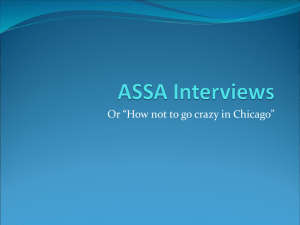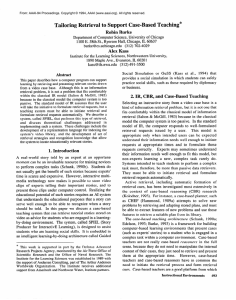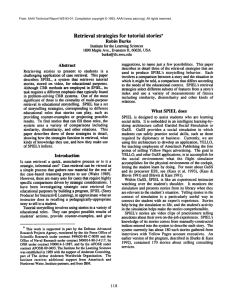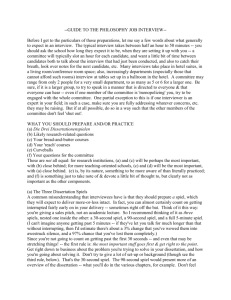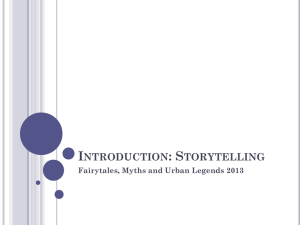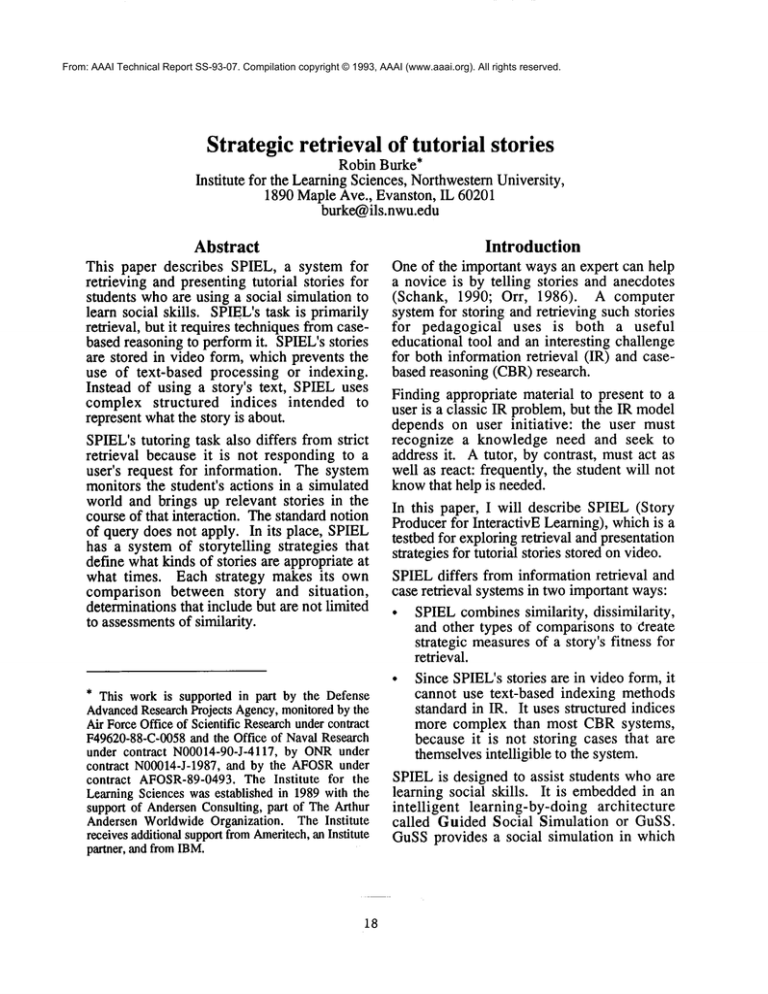
From: AAAI Technical Report SS-93-07. Compilation copyright © 1993, AAAI (www.aaai.org). All rights reserved.
Strategic retrieval of tutorial stories
Robin Burke*
Institute for the LearningSciences, NorthwesternUniversity,
1890 MapleAve., Evanston, IL 60201
burke@ils.nwu.edu
Abstract
Introduction
One of the important ways an expert can help
a novice is by telling stories and anecdotes
(Schank, 1990; Orr, 1986). A computer
system for storing and retrieving such stories
for pedagogical uses is both a useful
educational tool and an interesting challenge
for both information retrieval (IR) and casebased reasoning (CBR)research.
Finding appropriate material to present to a
user is a classic IR problem, but the IR model
depends on user initiative:
the user must
recognize a knowledge need and seek to
address it. A tutor, by contrast, must act as
well as react: frequently, the student will not
knowthat help is needed.
In this paper, I will describe SPIEL(Story
Producer for InteractivE Learning), which is
testbed for exploring retrieval and presentation
strategies for tutorial stories stored on video.
SPIELdiffers from information retrieval and
case retrieval systems in two important ways:
¯ SPIELcombinessimilarity, dissimilarity,
and other types of comparisons to dreate
strategic measuresof a story’s fitness for
retrieval.
¯ Since SPIEL’sstories are in video form, it
cannot use text-based indexing methods
* This workis supported in part by the Defense
Advanced
ResearchProjects Agency,monitoredby the
standard in IR. It uses structured indices
Air ForceOfficeof ScientificResearch
undercontract
more complex than most CBRsystems,
F49620-88-C-0058
and the Office of NavalResearch
because it is not storing cases that are
under contract N00014-90-J-4117,by ONRunder
themselvesintelligible to the system.
contract N00014-J-1987,and by the AFOSR
under
SPIELis designed to assist students whoare
contract AFOSR-89-0493.
The Institute for the
LearningScienceswasestablished in 1989with the
learning social skills. It is embeddedin an
supportof AndersenConsulting,part of TheArthur intelligent learning-by-doing architecture
AndersenWorldwideOrganization. The Institute
called Guided Social Simulation or GuSS.
receivesadditionalsupportfromAmeritech,
an Institute GuSSprovides a social simulation in which
partner, andfromIBM.
This paper describes SPIEL, a system for
retrieving and presenting tutorial stories for
students whoare using a social simulation to
learn social skills. SPIEL’stask is primarily
retrieval, but it requires techniques from casebased reasoning to performit. SPIEL’sstories
are stored in video form, which prevents the
use of text-based processing or indexing.
Instead of using a story’s text, SPIELuses
complex structured indices intended to
represent whatthe story is about.
SPIEL’stutoring task also differs from strict
retrieval because it is not responding to a
user’s request for information. The system
monitors the student’s actions in a simulated
world and brings up relevant stories in the
course of that interaction. Thestandard notion
of query does not apply. In its place, SPIEL
has a system of storytelling strategies that
define what kinds of stories are appropriate at
what times. Each strategy makes its own
comparison between story and situation,
determinations that include but are not limited
to assessmentsof similarity.
18
If you assumethat Mrs. Swain will not participate in the advertising decision for SwainRoofing,
you may be surprised. Here is a story in which an account executive madesimilar assumption
and was wrong:
[Video: ! went to this auto glass place one time where I had the biggest surprise. I walkedin; it
was big, burly man; he talked about auto glass. So we were working on a display ad for him. It
was kind of a rinky-dink shop and there was a TV playing and a lady there watching the TV. It
was a soap opera in the afternoon. I talked to the man a lot but yet the womanseemed to be
listening, she was asking a couple of questions. She talked about the soap opera a little bit and
about the weather.
It turns out that after he and I workedon the ad, he gave it to her to approve. It turns out that
after ! brought it back to approve, she approvedthe actual dollar amount.He was there to tell me
about the business, but his wife was there to hand over the check. So if l had ignored her or had
not given her the time of day or the respect that she was deserved, 1 wouldn’t have madethat sale.
It’s importantwhenyou walkin, to really listen to everyoneandto really pay attention to whatever
is goingon that you see.]
An assumption that a spouse will not participate in an advertising decision may be unrealistic.
Think carefully about your assumptions.
Example1, Telling the "Wife watching TV"story_
using the Warnabout assumntion storytelling strategy.
students can safely practice social skills, such
as those required by diplomacyor business.
Currently, we are using this architecture to
develop an application, YELLO,for teaching
employees of Ameritech Publishing the fine
points of selling Yellow Pages advertising.
The goal in YELLO, and other GuSS
applications, is to accomplish for the social
environment what the flight simulator
accomplishes for the physical environmentof
the cockpit. It allows the student to learn by
doing.
Within GuSS, SPIEL is like an experienced
pilot watchingover the student’s shoulder. It
monitors the simulation and presents stories
from its library whenthey are relevant to the
student’s situation. Telling stories in the
context of simulation is a particularly useful
way to connect the student with an expert’s
experience. Stories help bring the simulation
to life, and the student’s activity in the
simulation
helps make the stories
comprehensible.
19
YELLO
in action
Each YELLO
scenario begins with the student
in the office, receiving new accounts and
contacting customers in the same way a real
account executive would. One representative
scenario is as follows:
¯ The student finds that the account is for
"SwainRoofing" and the contact person is
Mr. Ed Swain. The student calls the client
and sets up an appointment.
¯ Uponarriving at the Swain’s home, she
meets LucySwain, Ed’s wife and finds that
Ed is not yet there.
¯ The student carries on small talk with
Lucy but does not discover that Lucy
"keeps the books" for the business and
fails to gather any business information
that Lucycould provide.
¯ Ed Swainarrives.
This is a good time to give somefeedback to
the student. She has misjudged Lucy’s role in
the business and missed an opportunity to get
some business information from an important
You were hostile towards Mrs. Swain. Unfortunately, she has convinced Ed not to buy, Here is a
story about a similar situation in which the salesperson used a different method and was
successful.
[Video: I went to this auto glass place one time whereI had the biggest surprise. I walked in; it
was big, burly man; he talked about auto glass. So we were working on a display ad for him. It
was kind of a rinky-dink shop and there was a TV playing and a lady there watching the TV. It
was a soap opera in the afternoon. I talked to the man a lot but yet the womanseemed to be
listening, she was asking a couple of questions. She talked about the soap opera a little bit and
about the weather.
It turns out that after he and I workedon the ad, he gave it to her to approve. It turns out that
after ! brought it back to approve, she approvedthe actual dollar amount. He was there to tell me
about the business, but his wife was there to handover the check. So if l had ignored her or had
not given her the time of day or the respect that she was deserved, I wouldn’t have madethat sale.
It’s important whenyou walk in, to really listen to everyoneand to really pay attention to whatever
is goingon that you see.]
You were hostile towards the client’s spouse. In the future, you might consider being considerate
whenmeeting membersof the client’s family.
Example2. Telling the "Wife watching TV"story_
using the Demonstrate
alternative alan storytelling strategy.
source. Without some feedback, the student
mightnot realize that this opportunityexisted.
One of the approximately 200 stories in
SPIEL’slibrary is relevant here. SPIELlights
up a button on the screen with the message:
"A warning about something you just did."
This tells the student that a story is available.
If the student chooses to view the story, a
video of the storyteller appears in a separate
screen. Example1 shows the text the student
sees on the screen, along with a transcription
of the video.
SPIEL precedes
each story with an
introductory paragraph called a bridge and
summarizes each with a coda paragraph. The
bridge explicitly connects the story with
context of the student’s activity; the coda
brings the student back to the events of the
simulation by suggesting some possible
actions.
This exampleshows the use of a storytelling
strategy called Warnabout assumption. By
observing the conversation with Lucy, the
system can gather evidence that the student
assumesher interaction with Lucywill not be
20
an importantpart of the sales call. It tells the
story to show howa similar assumption has
been foundinaccurate in a similar situation in
the past.
Storytelling strategies enable a storyteller to
makea variety of different points with the
same material. A teacher could use the "Wife
watching TV" story in a different way:
suppose the student were hostile and
dismissive towards Lucyduring the sales call,
resulting in a poor outcome. This would be a
good time to tell the story as a counterexample, as shown in Example 2. Here the
story shows how another salesperson
succeeded where thestudent failed.
These examplesillustrate the synergy between
simulation and storytelling. Withouta story to
provide the impetus to examinethe situation,
the student might never realize
what
opportunities had been missed. Without the
active engagementprovided by the simulation,
however, the student might lack the
motivation and context to listen, understand
and rememberthe story.
How stories teach
Theprimarychallenge for a tutorial storyteller
is to tell the right story at the right time. I
have approached this problem by analogy to
case-based reasoning. Like case-based
problem-solving systems, such as CHEF
(Hammond, 1986), SPIEL must locate
knowledge structures in its memory. CHEF
retrieved recipes using indices that describe
the types of dishes the recipes produce: the
cookinggoals they satisfy. SPIEL’sgoal is to
tell its stories in instructive ways.Its retrieval
system is therefore based on the kinds of
learning that stories can produce.
When students learn by performing an
activity, it is frequently because of failures:
unsuccessful results or unmet expectations.
Failure-driven learning theory (Schank, 1982)
holds that there is a central cycle in
performance learning. The learner makes
predictions about results of his or her own
actions or the behavior of others, and tests
these predictions by observing what happens.
If all goes well, these expectations feed into
decisions about the next action or prediction.
However,if the expectations fail, the learner
has failed to understand something about the
world. The problem helps focus attention on
exactly what maybe wrong in the student’s
thinking about the world. To prevent future
failures, the student must explain howthis one
occurred in sufficient detail to allow the
problemto be fixed.
Explanation is often the most difficult aspect
of the prediction-observation-failure-explanation cycle. Thestudent has to identify whythe
prediction was wrong and what to do to
prevent future errors. Stories can help this
kind of learning in two ways. If the student
has failed in some task, the story base can
recall a story that helps the student explain the
failure and recover from it. If the student is
heading in the wrongdirection without being
aware of it, a story can point out the problem
by showingwhere the direction is leading. It
21
can spur learning by getting the student to
recognizea failure.
In order for the story retriever to address the
student’s acutal and possible failures, it has to
be able to recognize the student’s mistakes. In
intelligent tutoring systems research, the
standard approach is to create a modelof the
student’s thinking and an expert’s thinking.
The differences betweenthe modelsconstitute
the things the student needsto learn.
There are a numberof reasons whythis is not
feasible for SPIEL.Noone "correct" modelof
expert social knowledge exists. People’s
understanding of social situations is for the
most part beyondthe capability of existing AI
models; it is large and idiosyncratic, tied to
culture and personal experience. Evenif such
modeling were possible,
the knowledge
necessary for building a modelwould have to
be laboriously extracted from each student.
A moresubtle problemis that an expert model
would, in some sense, be redundant with the
knowledge embeddedin the stories that the
system has. If SPIELidentifies a particular
action as dangerous,it is becauseit has a story
that showsthat the action can lead to disaster.
Stories themselves serve as the basis for
assessing whatis a possible failure.
Finding storytelling
opportunities
One way to think about the problem an
educationalstoryteller faces is to think of each
story as a possible lesson and each strategy as
a way to teach it. The storyteller wants to
communicate as many stories as possible;
storytelling strategies indicate the conditions
under which the goal of telling a story can be
achieved. Since a storyteller has manystories,
any one of which could be relevant at any
time, it is useful to think of it as an
opportunistic system.
The general problem of opportunism, locating
and respondingto opportunities for the pursuit
of multiple goals, is a difficult unsolved
problem in artificial intelligence. Birnbaum
Storage
Story
-~
Index - Indices
~ Storytelling
strategies
generation[
Opportunity-recognitionrules
Retrieval
Opportunity-recognition
rules
Events from
simulation ~ Marcher b Retrieved
story/strategy
Language
generator
Story with bridge and coda
Figure 1. SPIEL’st~rocessin~
(1986) argues that unboundedinference can
required to recognize a novel opportunity to
pursue a goal. However, the educational
storytelling problemin SPIELis a special case
of opportunism, one that is amenable to
solution.
Onedifficulty associated with noticing realworldopportunitiesis that it can be difficult to
predict how they can arise. Birnbaum uses
revenge as an example. There is no single
state of the world that canbe described as
constituting a "revenge opportunity." Such an
opportunity will always be a function of the
desires of the revengee and the actions
available to the revenger.
Educational storytelling is not so open-ended.
SPIEL’sstorytelling strategies comparestories
about activity to specific contexts of student
action. They seek coherence and relevance,
and do not look for distant analogies. It is
possible to describe concretely what an
22
opportunity would look like to tell a story
using a particular strategy.
Perhaps SPIEL’sstrongest advantage over the
problemof opportunismis that it is embedded
in a simulation. No truly novel actions can
occur in GuSSsince the student is constrained
by the program’s interface and the simulation
operates in known ways. SPIEL knows with
certainty what actions can and cannot happen
in its world.
SPIEL’s problem of opportunism is therefore
much simpler than the general one. The
simulated world provides a limited space in
whichevents can occur; storytelling strategies
single out precise areas of the space that
constitute opportunities. These properties
enable SPIELto use what Birnbaumcalls the
"elaborate and index" modelof opportunism:
"...spend some effort, whena goal is
formed, to determine a number of
situations in which it might be easily
satisfied...and then index the goal in
terms of all the features that might
arise in such situations." (page 146)
This model fails whenit is too difficult to
determineall of the situations in whicha goal
can be satisfied or to enumeratethe features of
such situations, but these are conditions that
SPIEL can meet. It is possible to do some
processing, whena story is stored in memory,
to determinethe situations in whichit could be
told and then prepare to recognize such
situations whenthey arise.
SPIELworks from its database of stories to
determine what should count as an opportunity
for intervention. Its processing can be divided
into two stages: storage time, when new
stories are put into the system; and retrieval
time, when a student interacts with a GuSS
system and gets tutorial feedback. Figure 1
showsthese phases.
At storage time:
1. Indices are attached to each story in the
database.
2. SPIEL’s storytelling
strategies
are
implemented by recognition condition
generators that are applied to each index.
If the strategy is applicable to the index, a
set of rules is generatedthat will recognize
an opportunity to tell that story using the
storytelling strategy.
3. Optimizations are performed on the final
opportunity-recognitionrule set.
At retrieval time:
1. Opportunity-recognition rules are matched
against the state of the simulation.
2. When the rules for a particular
combination of story and strategy match
successfully,the story is retrieved.
3. After retrieval, natural language bridge
and coda are generated to integrate the
story into the student’s current context.
In the following sections, I will describe
SPIEL’sindexing methodand the storytelling
23
strategies. A discussion of the system of
opportunity-recognition rules requires an
understandingof the internal operation of the
GuSSsimulation and is beyond the scope of
this paper.1
Indexing
SPIELuses video to communicateits stories
vividly and memorably. However, this
medium is much more demanding of an
indexing scheme than text. Video does not
support text-based processing or indexing. To
automate indexing would require speech (and
possibly gesture) recognition as well as natural
language understanding, technical challenges
well beyondour intent in designing a learning
environment.
In SPIEL, a humanindexer watches stories,
and uses an indexing tool to create indices.
The indexer is expected to knowenough about
the domain to understand the meaning of
stories, but does not need to knowhowthose
stories will appear in an educational context.
The indexer constructs indices that capture
different interpretations of a story’s meaning.
SPIEL’suses these characterizations of stories
to performits educational task.
The interpretation of the "Wife watching TV"
story that is at work in Example 1 goes
somethinglike this:
"The salesperson assumed the wife would
be a housewife, but actually she was a
business partner."
This is an anomaly, a failure of expectation
that requires explanation (Schank, 1982).
Typically, anomalous occurrences are what
makestories interesting and useful. Theyare
especially important in stories about social
activity since students in such areas need to
1GuSS’s
systemof decisionrules is coveredin (Kass,et
al., 1992).Theimplementation
of SPIEL’s
opportunityrecognitionrules withinthat systemis discussedin
(Burke,in preparation).
Setting: step-of-sales-process(salesperson,
presentation)
business-type(service)
business-size(small)
business-partnership(auto-glass
man, wife)
married(auto-glass man, wife)
sales-tarset(salesperson,
auto-glass company)
Anomaly: [salespersOnAssumed[ assumed [ wifeActual[ theme
Theme:
Goal:
Plan:
Result:
housewife
hospitality
small talk
business partner
help in decision
evaluate presentation
positive evaluation
sale for salesperson
Pos. side-effect:
Neg. side-effect:
Figure 2. Index for "Wife watching TV."
learn what to expect and howto explain and
address their failures. In stories about social
activity, anomalies usually take the general
form, "X believed Y, but actually Z."
SPIEL’s indices are considerably more
complex than those typically found in casebased reasoning systems. There are two
reasons for this complexity.
One reason has to do with the medium of
video. Because the retriever does not have
access to the content of what it is retrieving,
the index has to contain everything that the
retriever will need. This is not true in CBRor
IR systems. A CBRretriever retrieves cases,
represented in terms that the system uses for
problem-solving. If necessary, it can use the
contents of the case to makedecisions during
retrieval. Similarly, in information retrieval
systems, the textual contents of indexed
documents can be employed in retrieval
processing. SPIELcannot examine the "text"
of its video stories,
so indices must
compensate.
24
The other reason that SPIEL’s indices show
complexity is the task of educational
storytelling itself. Mostcase-based reasoning
systems are engagedin a single task, usually
problem-solving.
Cases serve only one
purpose: to supply candidate solutions. SPIEL
has a variety of reasons for telling stories;
each of its storytelling strategies uses the
index in a slightly different way. SPIELneeds
complex indices to meet the demands of a
variety of strategies.
Figure 2 shows an example of an index for
"Wife watching TV". As well as the anomaly,
the index describes
¯ the physical, temporal and social setting,
placing the story within the overall task
and within
a network of social
relationships.
° intentional chains that link plans of action
with the goals and themesthat give rise to
them and the results and side-effects that
follow from them, thereby explaining the
2anomalousparts of the story.
Storytellingstrategies
Tell a story about a desire that someone
had which was not realized when the
student appears to havea similar desire.
The opposite problemarises if a student is too
timid. Aimingtoo low is just as disastrous for
a salesperson as aiming too high. For a
student that showssuch fears, SPIELuses the
Warnabout pessimism strategy:
Tell a story about a fear that someonehad
which was not realized when the student
appearsto havethat fear.
Stories are intended to bring the real world of
practice into the simulation, whichis by nature
elror.
artificial and simplified. Oneof the important
benefits that stories can bring is to showthe
Each storytelling
strategy is a domainwaysin which the real world is different from
independent description of what kind of
the simulation. SPIEL has a story about a
stories
can be employed in what
circumstances. A strategy can be described by salesperson whocontinued conversing with a
cleint after makinga sale, and had the client
a simple conditional statement: "Tell a story
change his mind. If the student hangs around
about X when Y."
after a sale is closed, !SPIELcantell this story.
For example, the Warn about assumptions
It showsthe student that an action that works
strategy calls for the storyteller to
in the simulated world maybe disastrous on
the job. This the Demonstraterisks strategy.
Tell a story about an assumption that
someone made which did not hold when
Tell a story about a negative result of a
the student appears to have a similar
particular
course of action when the
assumption.
student has just executed a similar course
of action but had success.
This allows the storyteller to correct the
student’s mistaken assumptions, if it has a
The same logic holds when there is a story
story that showshowthat assumptioncan fail.
about a success that ensues from a particular
action, contrary to what the simulation shows.
SPIELhas two other strategies for dealing
Demonstrate opportunities is the name of
with erroneous beliefs that students mayhave.
the slrategy that presents this kind of story.
Students may have unrealistic hopes about
what they can achieve. For example, a student
Tell a story about a positive result of a
mighttry to sell an ad that is muchlarger than
particular
course of action when the
what the client needs. Given an appropriate
student has just executed a similar course
story, SPIEL could use the Warn about
of action but had a poor result.
optimismstrategy:
Stories can also teach students particular techniques and approaches. SPIEL takes advantage of the failure-based learning cycle to do
this. If it has a successstory, onewayto tell it
is to wait for the student to fail in a similar
2Thisindexstructure is derivedfromthe Universal situation and then tell the story to show a
IndexingFrame,reportedin (Schank,et al., 1990).See different wayto approach the samesituation.
also (Domeshek,
1992).
A tutorial storyteller needs indices to know
what its stories are about. It also needs to
knowhow stories can be usefully employed.
For maximumpedagogical impact, a story
must appear precisely at the time that the
student is prepared to learn from it. For
example, when the student has acted on the
basis of an incorrect assumption as in
Example1, it is a good time to tell a story
showing that such expectations are often in
25
This is the Demonstrate alternative plan
strategy from Example2.
Tell a story about a successful plan to
achieve a particular goal whenthe student
has executed a significantly-different plan
and failed to achievethe goal.
One of the important features of a learning
environmentis that students should get quick
feedback about howwell they are doing. It is
not always realistic to do so in a simulation,
since real salespeople often do not get such
feedback. However, SPIEL can intervene to
give feedback when the simulation is not
likely to.
For example, a student might use highpressure fear tactics to wina sale. In real life,
this endangers the salesperson’s chances of
selling to the customernext time around. This
consequence would not be apparent in the
YELLOsimulation,
however, since the
encounter with a client ends after one sale. A
story about the bad long-term consequencesof
such tactics would be told by the Warn
aboutplan strategy.
Tell a story about an unsuccessful plan
when the student has begun executing a
similar plan and will not get immediate
feedbackabout it.
The sameprinciple holds for successful sales
approaches with the Reinforceplan strategy:
Tell a story about a successful plan to
achieve a particular goal whenthe student
has just started to execute a similar plan
and will not get immediatefeedback about
it.
In a social domain, knowingwhat others are
doing is just as important as knowingwhat to
do oneself. Explainother’s plan is a strategy
for helping the student understand the actions
of other agents in the simulatedworld.
Tell a story about a plan that the student
might not know about when the student
has just observed someone in the
simulation execute a similar plan.
26
For example, SPIELhas a story about a client
whofelt it was his right to verbally abuse
salespeople. If the student encounters an
abusive client, SPIELcan use the story to
showthat somecustomersare just like that.
One interesting consequence of this set of
storytelling strategies is that SPIELcannot
restrict
itself to performing a simple
assessment of similarity whenretrieving. In
Example2, the storyteller presents a story that
is in some ways similar to the student’s
situation, butit shows someonehandling that
situation quite the opposite from the student’s
approach: being friendly instead of hostile.
The Demonstrate alternative plan strategy
calls for an examination of specific areas of
similarity and dissimilarity in the relation
betweenstory and situation.
It should also be noted that these storytelling
strategies are not specific to selling or to
business. They are useful for presenting
stories about any social activity to students
whoare practicing their social skills.
Conclusion
SPIELis a specialized retrieval system. It is
designed for the task of presenting pedagogical stories to students whoare learning by
interacting with a simulated environment.
Still, its construction has somebroaderlessons
for research at the boundaries of case-based
reasoning and information retrieval.
As video becomes a more commonsource of
information, the appeal of strictly text-based
approaches to ihdexing Will diminish. SPIEL
is an experiment in designing indices that
represent what stories are about richly enough
so that they can be employedin a variety of
ways. Such indices are by necessity complex,
but with an indexing tool that supplies the
format and the representational vocabulary, a
story can be indexed in a few minutes.
Building retrieval systems for specific tasks
helps illuminate the variety of uses to which
retrieved material can be put. A tutor needs to
makeits interventions directly relevant to the
student’s actions. SPIEL’snine storytelling
strategies describe different waysthat stories
can be made relevant. They incorporate
similarity judgments,but also are sensitive to
importantdifferences and other relations.
SPIELis therefore in a quite different position
from both a CBRretriever and IR system. In
CBR,a case is considered worth applying to
the current problem if it solves a similar
problem. In IR, a text is worth retrieving and
presenting to the user if it is similar, along
somemetric, to the user’s retrieval request. In
a tutorial situation, similarity remains
important, but it is not the only kind of
relation that is neededby SPIEL’sstorytelling
strategies.
References
Birnbaum, Lawrence A. (1986) Integrated
Pro~e~ing in Planning and Understanding.
PhDThesis, Yale University.
Burke, Robin (1992). Knowledgeacquisition
and education: a case for stories.
In
Proceedings of the AAAI Symposium on
Cognitive Aspects of KnowledgeAcquisition,
(pp. 39-46). Stanford University: AAAI.
Burke, Robin, & Alex Kass (1992).
Integrating Case Presentation with Simulationbased Learning-by-doing.
In Fourteenth
Annual Conference of the Cognitive Science
Society, (pp. 629-634). Bloomington, IN:
Lawrence Erlbaum Assoc.
Burke, Robin (1993). Intelligent retrieval
the video stories in a social simulation. In
Edu~t;i0n~l Multimedia and Hypermedia
Annual. To appear.
Burke, Robin (in preparation) Representation,
Storage and Retrieval of Stories in a Guided
So~iMSimulation. PhDthesis, Northwestern
University.
Domeshek, Eric A. (1992) Do the Right
Thing; A Component Theory for Indexing
27
Stories as Social Advice. PhDthesis,
University.
Yale
Hammond,Kristian J. (1986) Case-based
Planning: An Integrated Theory of Planning,
Learnin-~ and Memory. PhD thesis, Yale
University.
Kass, Alex, Robin Burke, Eli Blevis, & Mary
Williamson (1992). The GuSS Proiect:
Integrating Instruction and Practice through
Guided Social Simulation (Technical Report
No. 34). Institute for the LearningSciences.
Kolodner, Janet L., & Menachem Y. Jona
(1991). Case-based Reasoning: An Overview
(Technical Report No. 15). Institute for the
Learning Sciences.
Lave, Jean, & Etienne Wenger (1991).
Situated Learning: legitimate peripheral
participation. CambridgeUniversity Press.
Orr, Julian (1986). Narratives at work: Story
telling as cooperative diagnostic activity. In
Proceedings of the Conference on ComputerSupported Cooperative Work. Austin, TX.
Salton, Gerard, & Michael J. McGill (1983).
Introduction to moderninformation retrieval.
NewYork: McGraw-Hill.
Schank, Roger C. (1982). DynBmi~Memory;
A Theory of Learning in Computers and
People. CambridgeUniversity Press.
Schank, Roger C., et al. (1990). A Content
Th¢ory of Memory Indexing (Technical
Report No. 1). Institute for the Learning
Sciences.
Schank, Roger C. (1990).
Teaching
Architectures (Technical Report No. 3).
Institute for the LearningSciences.
Williams, Susan M. (1991). Putting CaseBa~ed Instruction into Context: Examples
from Legal. Business. and Medical Education
(Technical Report) Learning Technology
Center, Vanderbilt University.

